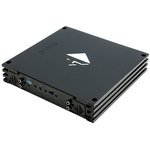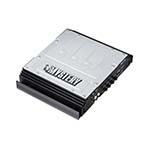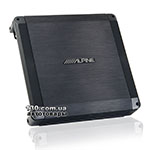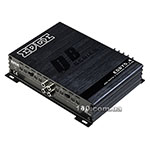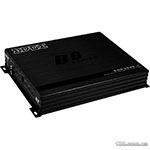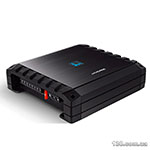How to connect the amplifier with a bridge?
Connecting an amplifier with a bridge can significantly improve performance and increase power. When "bridging" 2 channels are combined into 1, which helps to reduce the resistance level by about half, the power also grows by 2-2.5 times, since the channel capabilities are combined. In this mode, one of the channels works for (+), and the other for (-). Of course, the specific effect will be largely determined by the model of the sound amplifier used and the features of the system power supply. This connection option is very often used in the formation of car stereo systems, as it allows you to transfer a powerful monaural signal to a low-frequency speaker (subwoofer). This makes it possible to get an improved and richer bass sound.
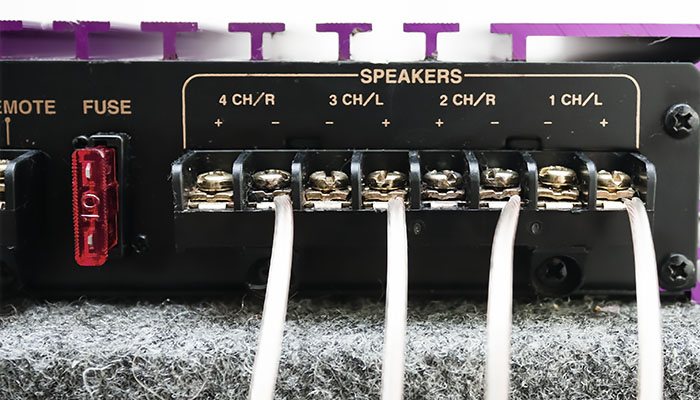
You can connect with the bridge not only 2 different channels of one 2-channel or 4-channel amplifier, but also 2 separate monoblocks. In this article we will analyze the implementation features of both options.
Features of bridge connection of car amplifiers
In general, the connection of the amplifier channels to the bridge assumes that a positively charged subwoofer wire is taken and connected to the positive terminal of one channel, and the negative is similarly connected to the negative terminal of the second channel. There is nothing complicated in this procedure, and you do not need to make any additional connections. The main thing is to make sure in advance that the available amplifier supports bridging before connecting. As a rule, this is written in the instructions and accompanying documentation for the device.
Now let's look at an example of the bridge connection order of a 2-channel and 4-channel sound amplifier.
Bridge connection of a 2-channel amplifier
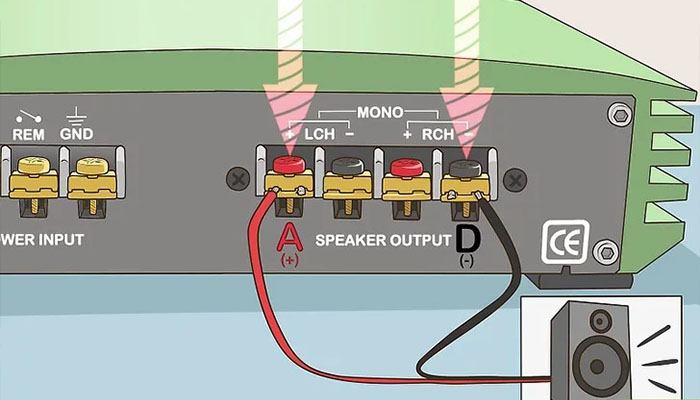
Here the procedure is as follows:
- Strip the contact wires of the speaker (subwoofer) before connecting. This is necessary so that when connecting, the contact is full and reliable.
- Connect the speaker to the amplifier, following the sequence: (+) connect the speaker wire to “A” connector (this is the (+) first channel), and (-) the speaker wire-to the “D” connector (this (-) the second channel).
- To connect the wire, first you need to unscrew the screw in the connector, then insert the wire between the terminals of the connector and fix the contact as tight as possible by tightening the screw.
Bridge connection of a 4-channel amplifier
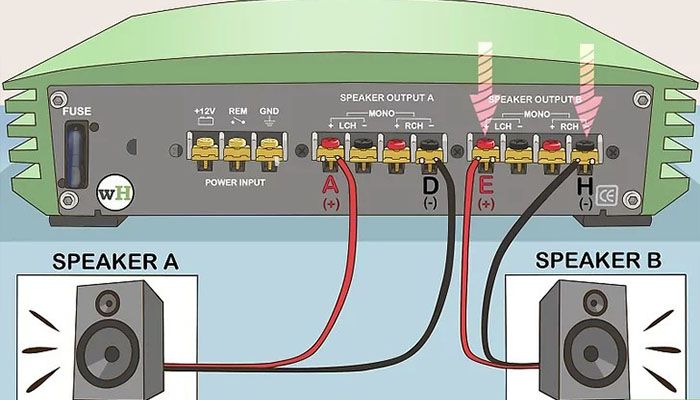
In this case, the procedure is almost the same as the previous one, the only difference is that the procedure will have to be done twice, since two speakers are connected here, one for each two amplifier channels connected to the bridge:
- Strip the contact wires on the speakers and/or subwoofer before connecting. This is necessary so that when connecting, the contact is full and reliable.
- Connect the first speaker to the amplifier first, following the sequence: (+) connect the speaker wire to “A” connector (this is (+) the first channel), and (-) the speaker wire-to the “D” connector (this (-) second channel).
- Now you can connect the second speaker, following the sequence: (+) connect the speaker wire to the "E" connector (this is the (+) third channel), and (-) the speaker wire-to the "H" connector (this is the (-) fourth channel).
- To connect the wiring as in the case of a 2-channel amplifier, first unscrew the screw in the amplifier connector, insert the wire between the terminals of the connector and carefully tighten the screw back. Check that the wire is securely fixed.
Connect two separate amplifiers to a bridge
If the sound amplifier is suitable and can be connected by a bridge to the second, then on the rear panel it has a special MASTER/SLAVE toggle switch. It means, that when implementing a bridge connection, the first device will act as a master amplifier (Master), and the second as a slave (Slave). Before connecting, you need to install on each switch in the desired position.
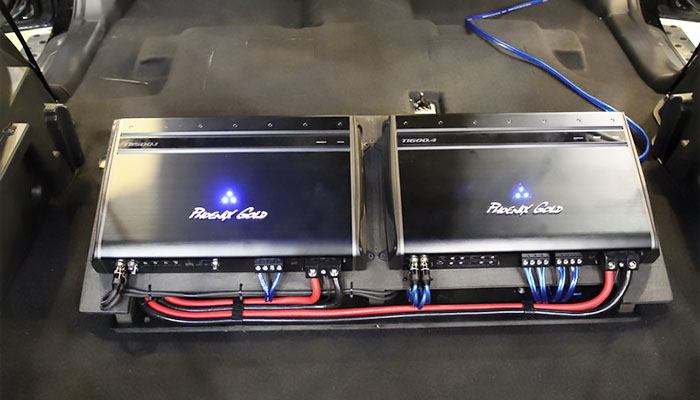
Please note that all cables from the car radio will need to be connected to the amplifier that will be the main one. And only then from it, using a mono connector, the signal will be transmitted to the second amplifier. This allows you to achieve convenience during operation, as it allows you to fully configure and control the speaker system using only one monoblock (Master). That is, it is on it, and only on it, the user will set all the settings, frequency filters, etc. No Y splinters will be required to connect to the second amplifier (Slave).
Sometimes the amplifier is not equipped with a switch, despite the fact that the manufacturer claims the possibility of bridge connection of amplifiers. In this case, look carefully at the back panel, there you should find two separate sockets that have signatures: Bridge Input and Bridge Output. To get a bridge connection, on the amplifier that will be the master, the connection is to the Bridge Output, then it is connected to the Bridge Input on the slave amplifier.
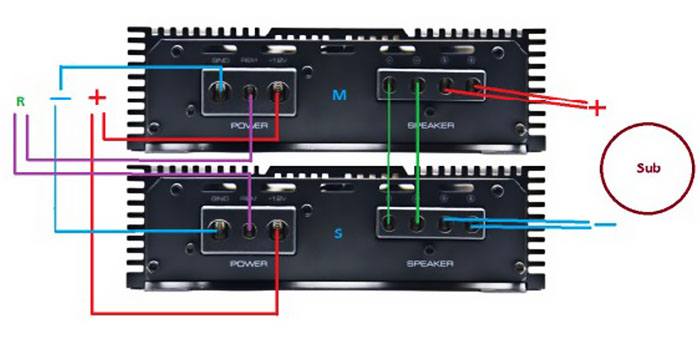
When connecting two amplifiers with a bridge, the order of connecting the wires should be as follows:
- First, connect the (-) connectors of the two amplifiers.
- Then connect the (+) contact from the main amplifier to the (+) subwoofer, and the (+) slave to the (-) subwoofer.
Yes, that's right, 2 positive wires connect to the subwoofer that's right!
This is due to the fact that the input of one amplifier receives a direct signal, and the second one flips the signal 180 degrees. This will give the necessary effect, since the positive potential increases at the output of the first due to a decrease in resistance, and at the output of the second you get the same increased signal, but with a negative charge.
Important points to consider when bridging
- Before connecting, always check if your amplifier supports bridging.
- Make sure that your device is capable of supporting the required resistance. There is a very strict rule: the amplifier must have a working impedance higher than the lowest acceptable value for it. For example, when the impedance of 2 ohms is minimal for your device, you should connect it so that the operating resistance is at 4 ohms. If it falls below the minimum value set by the manufacturer, the device may simply turn off.
- We must not forget that if two amplifiers are connected to the bridge, then the protection can be disabled at the slave. This must be taken into account and carefully monitored.
- You cannot connect different channels/amplifiers separately to the coils.
- Particular attention should be paid when bridging car speakers to a 4-channel amplifier. Sometimes this can cause a sharp increase in the load on the generator or subwoofer.
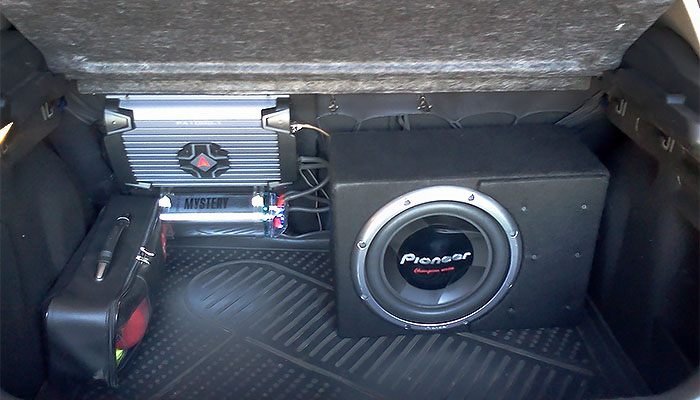
Now you know exactly what to do if you want to connect a subwoofer with a bridge to an amplifier or connect two separate sound amplifiers with each other by a bridge. As you can see, everything is simple here, and any motorist will figure it out. If you only plan to upgrade the audio system in your car, then in the online store 130.com.ua you can always buy an amplifier in Kiev, Kharkov and Odessa. Also, if necessary, our managers will help you choose a set of speakers or a subwoofer.
Related Materials:
Car sound amplifiers: Best Sellers

Stay tuned for updates!
Subscribe to our Telegram channel and be the first to receive useful materials.
Subscribe






















